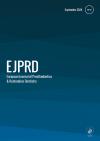European Journal of Prosthodontics and Restorative Dentistry
Ability of Six Curing Lights to Photocure Four Resin-Based Composites in a MOD-Mold: A Double-Blind Study
Abstract
Objective: The ability of six curing lights to photocure four resin-based composites (RBCs) in a mold simulating a cavity was compared visually. Materials and Methods: Four RBCs were photocured using the: Woodpecker B for 2x10s, SmartLite Pro 2x10s, Valo Cordless 2x10s, Valo Cordless 2x3s Xtra power, Valo X 2x10s, Valo X 2x5s Xtra power, PowerCure 2x3s mode, Monet 1x1s and Monet 3x1s, in a mold representing a molar Class II restoration. Immediately after photocuring, the RBC specimens were immersed in a solvent to remove the uncured RBC, after which they were photographed and de-identified. Using a REDCap survey, these images were compared visually to compare the ability of the LCUs to photocure the restorations. Results: There were significant differences in how well the LCUs had photocured the RBCs. The SmartLite Pro and Valo X used for two 10s exposures produced restorations rated as the best cured, and the Monet used for 1 s was rated the worst. Conclusions: There were visually apparent differences in how well the LCUs could photocure the RBCs. The Monet used for 1 second produced the worst results for all four RBCs.
Keywords
Dental Curing Lights
Resin-Based Composites
Laser Diode Curing Light
Depth of Cure Mold
ISO4049
Authors
John C. Comisi, Richard B. Price, Kern Kinley-Howard, Cristiane Maucoski, Erica Rader
Articles from this issue
 Free Access
Free Access No Access
No Access Full Access
Full Access


